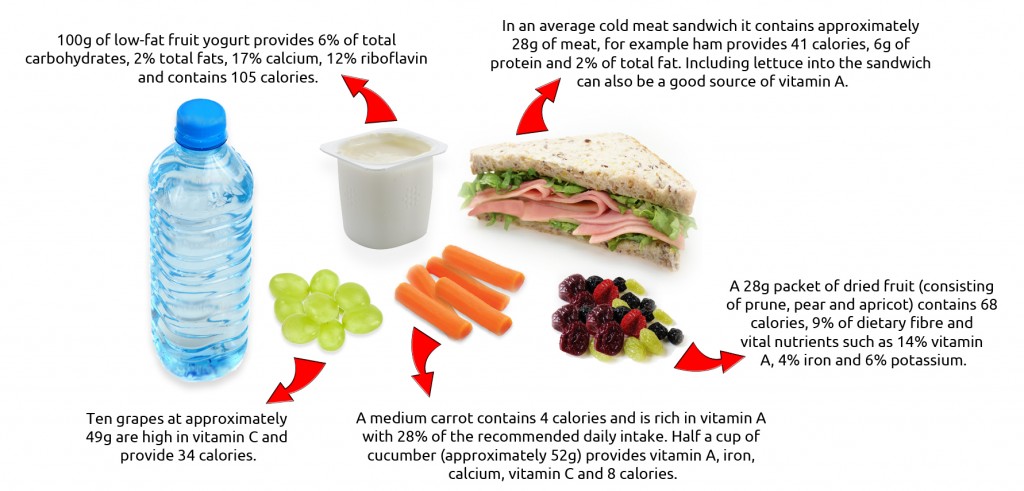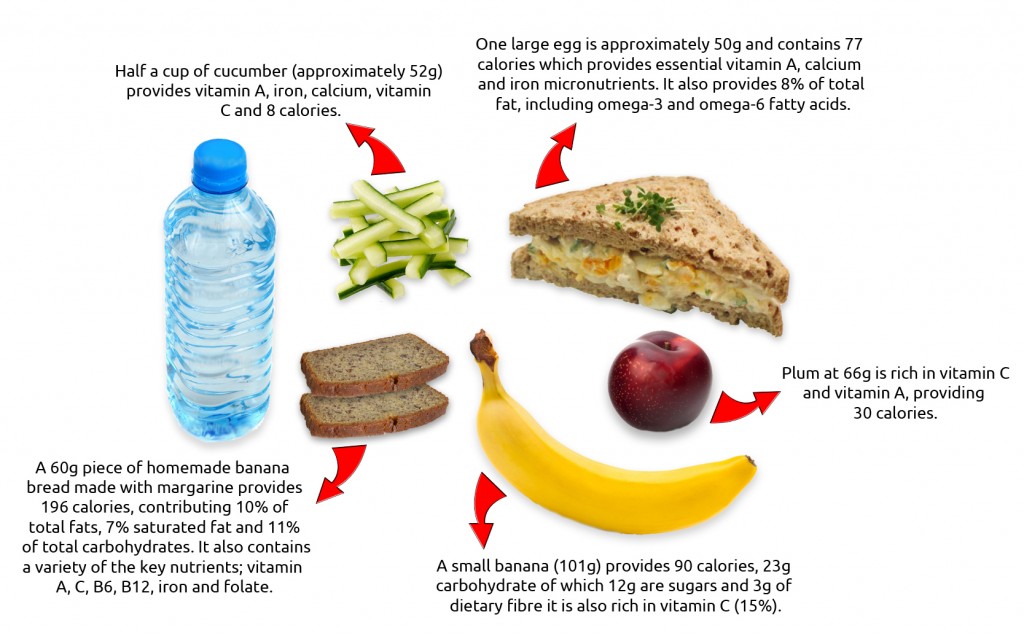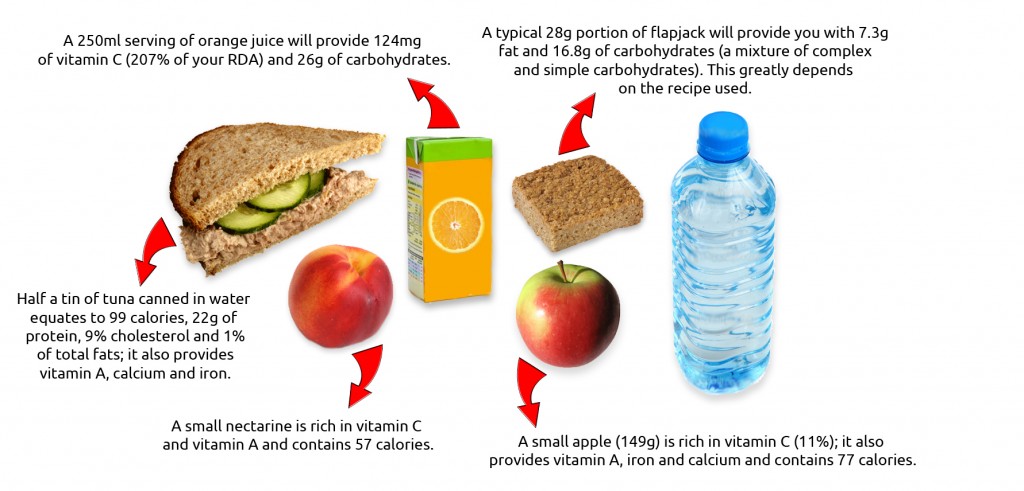As children do not understand the importance of eating healthy food, it can be very difficult for them to eat nutritious meals. As a result, meals which you prepare for your children have to be a balance of taste and health – something which can be difficult. This article will outline the importance of child health, give suggestions on how to get children more involved with their food, and provided some simple healthy lunchbox ideas.
Why is it important for children to follow a healthy balanced diet? Here are just a few reasons:
- Obesity levels are rising- leading to a variety of diseases and ill health (Reilly J, 2003). Therefore:
- There should be less emphasis on snacking, convenience foods and eating out as this can cause difficulty when trying to obtain a balanced diet even at a young age.
- Reducing foods that are high in fat, sugar and salt- however it must be noted that fat is a vital macronutrient in a child’s diet and there should be more emphasis on eating healthy fats, and reducing unhealthy fats.
- It is important for children to understand the difference between healthy and less healthy foods- what is a ‘treat’ and what is acceptable to eat every day.
- Educating and encouraging children from a young age is where trends for their future lifestyle begin.
- If essential nutrients are missed in the diet it can cause deficiencies for example, Iron deficiency anaemia reduces the number of red blood cells that can cause breathing problems and more.
Importance of healthy eating for children
Normal growth and development is vital in Children and has a considerable impact on their short and long term health. Physical activity and a healthy balanced diet provides adequate energy and nutrients, essential for a child’s well-being. In this day and age just telling parents that you need to provide a healthy balanced diet has a different meaning for each individual. What constitutes a healthy diet? What is a balanced diet?
Children grow rapidly and have a greater energy requirement per kilogram of body weight than adults (Theobald H, 2007). Energy and nutrient requirements vary according to the Child’s age. From the age of five it is advised that children should begin following the same healthy eating principles as those recommended in adults (Theobald H, 2007).
Protein is required for tissue growth and repair, meat, fish, eggs and pulses are perfect examples of protein in a diet (Theobald H, 2007). Fish is a brilliant source of omega-3-fatty acid, derived from the essential fatty acid; alpha-linolenic acid (BNF, 2000). It is an essential fatty acid because it is not synthesised in the body (along with omega-6-fatty acid), and is important in the formation of new tissues and the development of the brain, nervous tissue and retina (BNF, 2000).
Children up to the age of six are active and growing rapidly, however they have small stomach capacity and appetites. Eating little and often is the best way to ensure your child does not miss out on vital nutrient (Theobald H, 2007). Fibre-rich diets fill small stomach quickly and although fibre such as wholegrain bread and breakfast cereal is important in the diet it can cause children to eat less or not gain the nutrients they require because they are not hungry (Theobald H, 2007). Fat is an important source of energy and a number of foods including whole milk is a rich source of vitamins.
Micronutrients such as iron, zinc, vitamin D, vitamin A and calcium are essential for normal bodily function. Vitamin D and calcium are essential for the formation of healthy strong bones; milk and dairy products are rich in calcium and eggs and oily fish are sources of vitamin D, breakfast cereals are now fortified with vitamin D and calcium too, however beware of breakfast cereals high in sugar (Theobald H, 2007). Zinc is found in meat, fish, bread and breakfast cereals and is required for growth, tissue repair and immune function. Iron is also needed for normal immune function; it is found in meat and plays a role in metabolism and the formation of red blood cells (Theobald H, 2007). Whole milk, cheese, green leafy vegetables and butter are just a few sources rich in vitamin A, contributing to normal growth and development, immune function and normal vision (Theobald H, 2007).
Simple interventions to enhancing your Children’s diet
- Concentrate meals around starchy foods such as pasta, rice, bread and cereals; these foods will improve satiety within the whole family.
- Incorporating colourful foods- often this represents a nutrient rich source and eating a variety of foods will provide different nutrients; essential for growth and development.
- Allowing them to choose 2-3 pieces of fruit/ vegetables to go into their lunch box; carrot and cucumber sticks, apple, banana, orange- this is a great way to enhance nutrient intake from a variety of foods.
- Frozen, dried or canned fruits and vegetables all count as one portion and even 100% pure fruit or vegetable juice counts!
- Involving them in the process of shopping for the food
- making meals
- Encouraging them to spread their own toast or pour their milk onto their cereal etc.
- Encourage the whole family to prepare lunchboxes the evening before as an activity that they do together- the children can spread the margarine/put the ham in their sandwich and will become part of their daily routine.
The 5 a day fruit and vegetable recommendation is rarely met in the UK. However, fruit and veg are rich in antioxidants such as vitamin C, folate and potassium (Steffan L, 2006). Potassium is critically important in the optimal function of organs; vitamin C has a wealth of physiological roles in the body but is best known as an antioxidant, reducing free radical damage in cells. Food habits are developed during childhood therefore it is vital that children obtain these disease reducing nutrients as they will carry these with them into adulthood.
Sample lunchbox ideas
Lunch Box 1
- Ham lettuce sandwich
- Packet of dried fruit and grapes
- Carrot sticks
- Yoghurt
- Bottle of Water

Lunch Box 2
- Egg sandwich
- Cucumber sticks
- Plum and Banana
- Homemade banana bread
- Bottle of water

Lunch Box 3
- Tuna sandwich
- Nectarine and an apple
- Flapjack
- Fruit Juice and a bottle of water

Download and print out the lunchbox ideas here: lunchbox-ideas
Summary
Understanding the nutritional requirement of children is very important. There body is undergoing rapid growth and development, and if their nutritional requirements are not met it can lead to health difficulties later in life. Making food tasty, fun and healthy are all important factors to ensure children take an interest in food and are healthy.
Main image courtesy of anotherlunch.com.
References
BNF, B. N. F., 2000. n-3 Fatty acids and Health summary, s.l.: British Nutrition Foundation.
Reilly J, 2003. Health consequences of obesity. Archives of Disease in Childhood , Volume 88, pp. 748-752.
Steffan L, 2006. Eat your Fruit and Vegetables. THE LANCET, 367(9507), pp. 278-279.
Theobald H, 2007. Childhood Nutrition. Journal of Community Nursing , 21(2), pp. 25-28.

